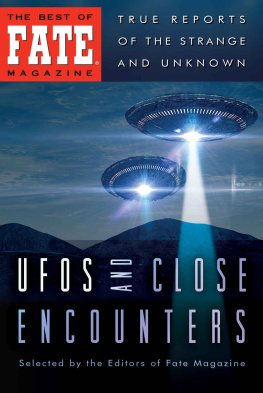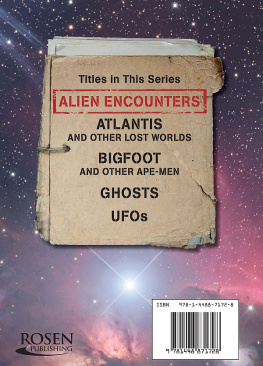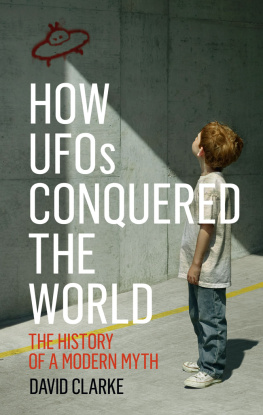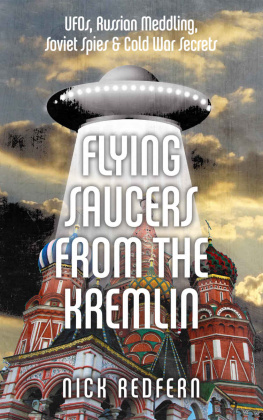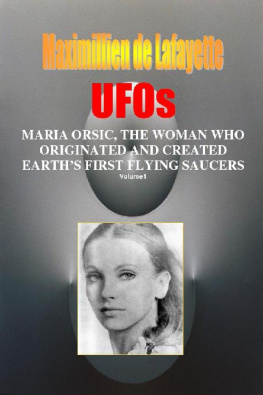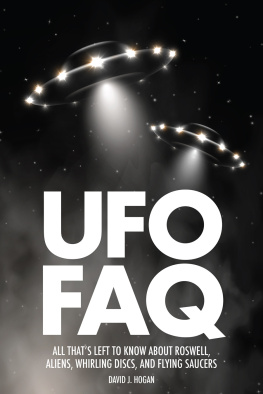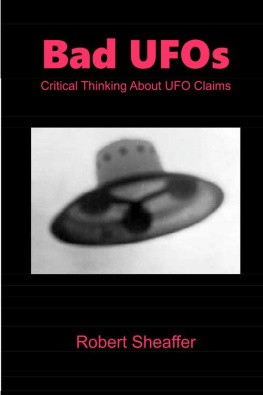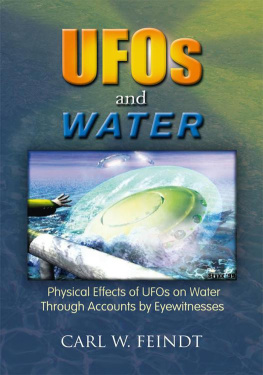Fate Magazine, Inc.
Copyright 2014 Fate Magazine Inc. 9781615085859. All rights reserved, including the right to reproduce this work in any form whatsoever without permission in writing from the publisher except for brief passages in connection with a review. For information, write: Fate Magazine, Inc. POB 460., Lakeville MN 55044
Psychic Healing and Spiritual Healing: Cases of Miraculous Recoveries (Oct. 2014)
Angels and Heavenly Encounters (Nov. 2014)
The World's Strangest True Stories (Oct. 2014)
True Stories of Strange Mysteries (Nov. 2014)
To Raymond A. Palmer,
Introduction
Unidentified Flying Objects [UFOS] did not suddenly spring into being on June 24, 1947, the day pilot Kenneth Arnold saw nine somethings zipping over the Cascades. In fact, even the moniker "flying saucer" was nothing new precisely sixty-nine and a half years earlier, on January 24, 1878, John Martin saw a "saucer" (his word) flying at "wonderful speed" over his Denison, Texas, farm.
There were, of course, others. UFOs go back a long way. Just how far back is, for want of any better method of making such a judgment, a matter of personal taste. If you believe Erich Von Daniken, and our own tastes compel us to admit we do not, then the damned things have been with Homo sapiens since before there were Homo sapiens. A trifle less speculatively, we can point to various odd references to "flying shields" and such in ancient Greek and Roman documents, though to these the skeptics can retort reasonably that in those days people didn't understand such natural phenomena as meteors, sundogs, and mirages very well and were likely to view as magical things that to us are merely mundane.
But as the centuries pass and as human beings begin to understand their environment better, reports of strange shapes in the sky (and sometimes on the ground) continue and the likelihood of easy, conventional explanation grows ever less certain. The late Charles Fort, in four memorable books published between 1919 and 1932, collected hundreds of accounts of odd aerial manifestations whose appearances had been noted in scientific journals, newspapers, and logbooks throughout the eighteenth and nineteenth centuries. And in 1896 and 1897 thousands of presumably sane and sober Americans swore they had seen "airships" sailing overhead; between November of the former year and May of the latter, the first UFO wave of modern times had heads angled upward, skeptics sneering and hoaxers working overtime. Similar events took place in the British Isles and New Zealand in 1909, in England in 1912 and 1913, and South Africa in 1914. From the beginning, whenever exactly that was, UFOs have been a worldwide phenomenon. The "foo fighters," weird amorphous lights which chased military aircraft during World War II and which no one has ever been able to explain, appeared over central Europe and the South Pacific. The "ghost rockets" of 1946 plagued Scandinavia and sparked unfounded fears about an imminent Soviet attack.
UFOs in vast numbers (Gallup Poll figures suggest there may be over two million valid sightings in this country alone) seem to be a product of the postwar period, which is to say that, while they may have been around before, they are far more inescapably around today. Even if the press had not happened, more or less by accident, to focus on Arnold's sighting (a routine one by present standards) and to direct mass attention to the event, "flying saucers" would have been on everybody's mind in fairly short order simply because it would have been impossible to ignore them.
Arnold's sighting occurred during the early stages of the first nationwide American UFO flap since 1897. There had been some good sightings in the days and weeks before it and there would be many others in the days and weeks after it. There would even be a small number of what Dr. J. Allen Hynek a quarter of a century later would delicately term "close encounters of the third kind": alleged sightings of humanoid UFO occupants. And the sightingswhether they were of puzzling nocturnal lights, daylight discs, cloud cigars, spheres, triangles, flying wings, or little colored men in diving suitswould not stop, no matter how many times over the next sixty-some years authority figures and self-appointed debunkers would predict their imminent demise or demand they cease and desist from further assaults on the sensibilities of establishment metaphysicians.
But all that was in the future when, in 1947, Curtis Fuller and Raymond "Ray" Palmer decided they did not want to move to New York City. Fuller, editor of Flying, and Palmer, editor of Amazing Stories, were content to remain in Chicago, which their superiors at Ziff-Davis Publishing Company, who were moving to Manhattan, were not. As Fuller and Palmer pondered their prospects, Palmer suggested they start their own magazine to deal with flying saucers and other unexplained phenomena. Palmer, who had published material on "true mysteries" (and some perhaps not so true) in the pages of his science-fiction magazine, was already familiar with the general subject matter, and Fuller was learning fast as, in his travels for Flying, he met and talked with pilots who had had their own UFO sightings.
Fuller liked the idea and came up with the title Fate, which didn't exactly describe the magazines contents but still had a nice provocative ring to it. So the two men put together the first issue of their magazine, which appeared on the stands in the spring of 1948.
The very first article, entitled "I Did See the Flying Disks!", was by Kenneth Arnold himself. In the same issue Arnold would recount his investigation into the enigmatic, still controversial, Maury Island incident.
Fate was off and running. It has just published its 723th issue as we revise this Introduction in 2014 and it's still going strong.
Because Fate was the first national magazine to treat UFOs both sympathetically and responsiblyit has never hesitated, when the occasion called for it, to identify hogwash by its proper name and over the years it has exposed a number of fraudulent claimsin 1977 the magazine sponsored a conference to celebrate the thirtieth anniversary of Arnold's historic experience. Arnold, still living in Idaho, still puzzled by the things he saw that legendary day, was Fate's choice for speaker, naturally. The magazine also called on a number of this country's leading ufologists, individuals who contributed measurably to our understanding, such as it is, of the "flying saucer" mystery to discuss what they had learned about Unidentified Flying Objects over the prior three decades.
From June 24 through June 26, 1977, the International UFO Congress met at Chicago's Pick-Congress Hotel to review the past and consider the future. The participants agreed that UFOs are real and still to be explained, but beyond that they held widely differing, often conflicting views. That is only to be expected. The UFO phenomenon is so vast and its manifestations so various that no single explanation seems likely to account for more than a part of the whole, and a subject of such awesome dimensions surely has room for both a Stanton Friedman, who sees UFOs as hardware, and a Jacques Vallee, who sees them as paranormal software. It also has room for any number of opinions somewhere between these two. Such a subject does not have room, however, for foggy-mindedness, rigid dogmatism, or uncontained credulityqualities all too much in evidence throughout much of the history of the UFO phenomenon. In the pages ahead you will find, we hope, none of these.

